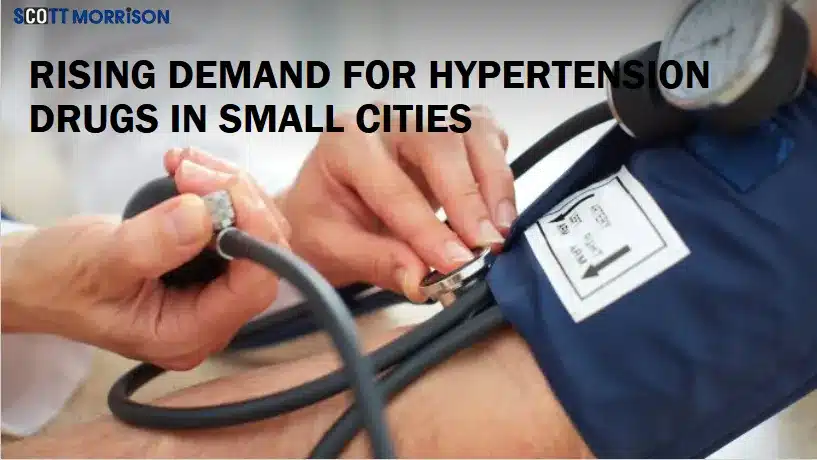Rising Demand for Hypertension Drugs in Small Cities
Hypertension and high blood pressure are very common in India. However, only older people living in metropolitan cities suffer from high blood pressure. But now, many more people living in Tier II and III towns and villages are being diagnosed. Thus, the demand for hypertension medicines is on the rise in small cities.
This represents a major opportunity for the pharmaceutical industry. Pharmaceutical makers and distributors of blood pressure medicines could specifically target the growth of these drugs and the needs of this emerging population.
Table of Contents
ToggleWhat is Hypertension?
Hypertension occurs when blood pressure is too high for a long time. Many people refer to hypertension as a “silent killer”. Because hypertension does not have clear symptoms. People who are diagnosed with high blood pressure should go for treatment before getting sick. It can cause more serious issues like heart attack, stroke, or kidney failure.
Most individuals living with hypertension will be put on a daily medication, for most, for a lifetime. Other health issues with managing hypertension can be regular check-ups and sometimes dietary changes and physical activity. However, people cannot manage their hypertension without access to medications.
Why Is Demand for Hypertension Medicines Growing in Small Cities?
1. Lifestyle changes
People living in small towns are healthier than those living in big cities because of physical activity and home-cooked foods. But it has changed now. People eat more processed food, work at desk jobs, and have stressful lifestyles. These all lead to an increased chance of having high blood pressure.
2. More Awareness
People in small towns now have greater awareness of hypertension thanks to government initiatives, social media, and their local doctors. More people are having tests for it, and being diagnosed with it naturally leads to a higher demand for blood pressure medicines.
3. Growing Middle-Class Population
The rising middle class in small cities will provide better access to healthcare. This means people will see their doctor more frequently, purchase medicines, and consider their health more seriously. This has created a much larger market for chronic disease medicines like antihypertensives.
4. Long-Term Treatment
Once hypertensive, patients will need to take daily medication, creating a steady, long-term, and continued demand for medicines. Patients do not stop taking medicines after a period, like some illnesses; antihypertensives are needed indefinitely.
What Does This Mean for The Pharmaceutical Industry?
The growth in the small cities offers many new opportunities for the pharmaceutical companies, distributors, and retailers.
1. Expand Distribution Networks
The companies should focus on a strong distribution system in Tier 2 and Tier 3 cities. The pharmacies need a proper supply of common hypertension medicines like amlodipine, losartan, telmisartan, and atenolol.
2. Affordable Medicines
The people in the small town are more price sensitive. The companies that provide low-cost, good-quality generic medicines can grow the market. The price of the medicines plays a big role in winning customer loyalty and trust.
3. Train Pharmacists and Doctors
Pharmaceutical companies should invest in educating the local doctors and pharmacists. Better knowledge leads to better prescribing, and it can improve the visibility of the sales.
4. Focus on Fixed Dose Combinations (FDCs)
Fixed-dose combinations are easy for the patients to take. They improve the medicine’s compliance and simplify treatment. The companies offering FDCs for hypertension are likely to gain market share in rural and semi-urban India.
Challenges to Consider
While demand is increasing, we still see some barriers that limit the full capacity of small city markets.
1. Supply Chain Issues
Transportation and storage in rural settings can be difficult. Roads, warehousing, and logistics systems are unpredictable. This inconsistency causes stockouts or delays in the delivery of medicines.
2. Untrained Workforce
In many small towns, pharmacists and other healthcare workers do not receive proper training. Perhaps they do not know what advice to provide, or they lose track of whether their patients are adhering to the treatment plan.
3. Brand Rivalry
Hypertension drug brands exist in generous supply. Marketers have to differentiate themselves based on trust, consistency, and value to get attention from all these competitors.
Opportunities Going Forward
The Indian pharmaceutical industry has a magnificent opportunity to respond to the demand for hypertension treatment in smaller cities and towns. Here are ways that companies can capitalize on this development:
1. Focus on Regional Expansion
In India’s expanding pharmaceutical horizon, pharma companies are beginning to expand sales teams and logistics sales capabilities beyond metropolitan cities. Many of the expansion opportunities exist in smaller districts and talukas. Expansion opportunities exist in middle-order cities. Grow this population.
2. Collaborate with Local Clinics
Collaborate with doctors and clinics in rural pathways. Helping clinics with awareness campaigns, free local camps, and product samples creates trust relationships and ensures success for the long term.
3. Incorporate Digital Mechanisms
Use apps, SMS reminders, and WhatsApp-related comms for direct communication with patients. People in rural areas have smartphones now. Digital interventions can help them manage adherence to medicines.
Conclusion
The increase in demand for hypertension medications in smaller cities in India indicates that healthcare is reaching greater populations. This is also an indicator that people are becoming health-engaged and are going to work on their health issues. For the pharmaceutical industry, this is an opportunity to expand into new territories and serve the health care needs of the nation.
FAQs—Frequently Asked Questions
Q1: Why is hypertension rising in small cities?
People living in small cities have higher body weight because they are not very active and are more stressed. Additionally, they have also adopted the urban trends that can increase the high blood pressure issues.
Q2: What medicines help to treat hypertension?
The most common medicines are amlodipine, losartan, telmisartan, enalapril, and atenolol. Some physicians are also prescribing combination pills.
Q3: Are people in smaller cities aware of their condition?
People are getting more aware of their health, but many people do not understand hypertension. The routine checkups and public health campaigns can help improve awareness.
Q4: Is there growing market potential for hypertension medications in smaller cities?
Yes. It is growing very quickly. More and more people are being diagnosed, and it is often a lifelong treatment. This means there will be a steady and long-term demand for medicines.






